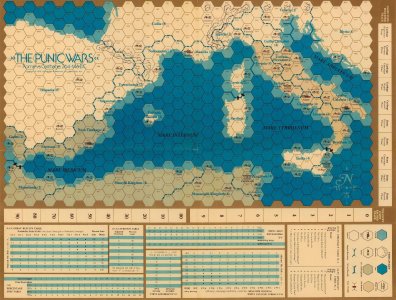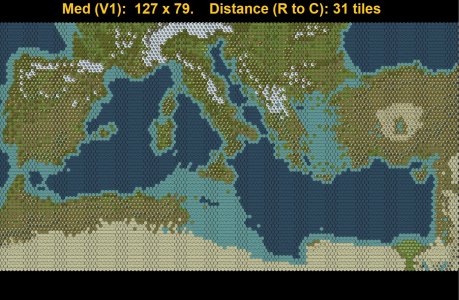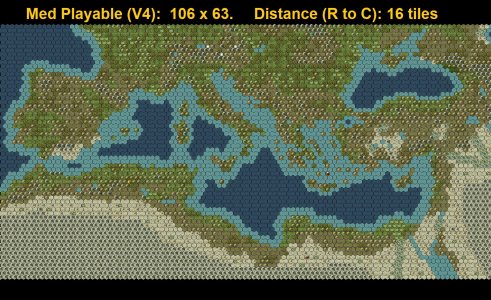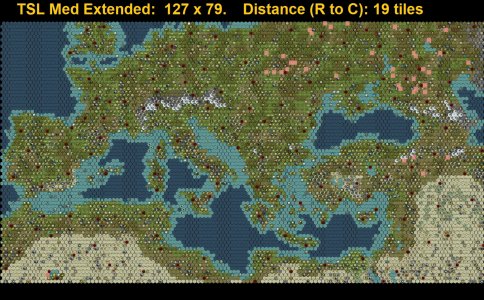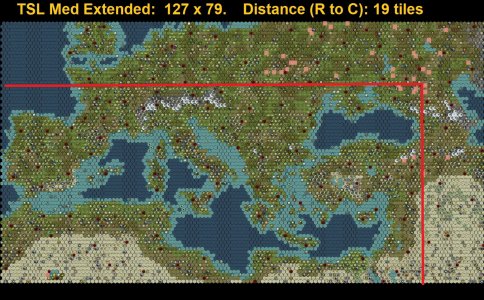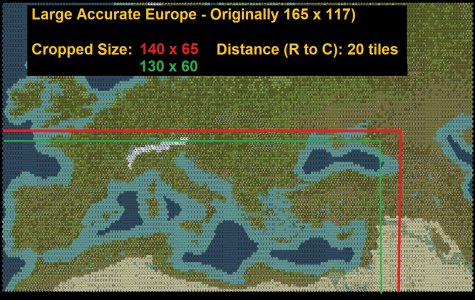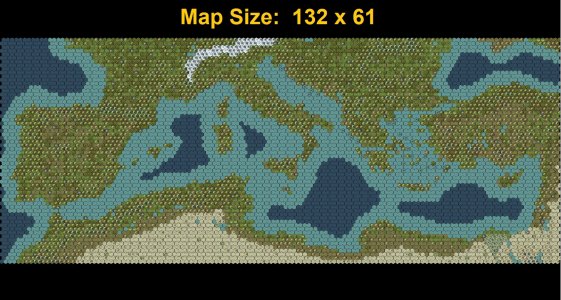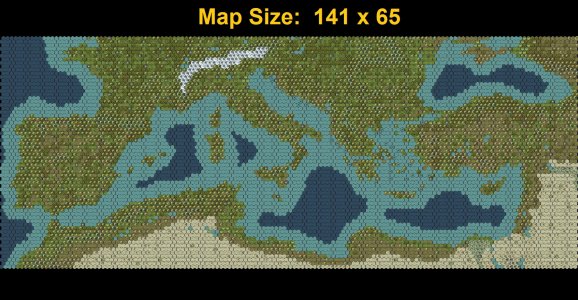Thanks,
@Mantis Toboggan M.D. for getting back with me. Pardon, while I response to your responses to my responses...

#2. Great. I'll try to come up with a nice, balanced unit-friendly UA, let me know if you do the same. Basically, anything you've seen in the civs/custom civs (from other modders) should be doable.
#3. I recommended making most other civs playable, as the methods available in the API are definitely more useful in controlling AI behavior if the civ is playable. The city state methods are rather coarse, and we don't have a lot of ways of interacting with them other than starting wars, forcing peace, and alliances on them. Allowing more playable civs not only offer a chance for someone to play some Hispania spoiler. With only 2 civs playing, the chances to rewrite history seem much smaller, only 50:50. The main drawback is the method available to "dictate" to the AI civs how they feel about each other (and human players). It's the same method used by the DLC scenarios, but in my experience they seem a little underwhelming. In such a case, Syracuse would definitely be a playable civ, Massilia, too. As "power brokers" a strong case could be made for a decent playable Macedonia, and very weak playable civs in Hispania, Gallia, and Illyria. Civs with no real prospect of winning the game, except through military conquest, and a tremendous amount of divine intervention. If you refer to the map on post #6, you'll see a lot of "provinces" shown. They don't technically belong to either side (as the board game had 3 separate scenarios, at different times, each of these provinces belonged to various sides. These should/could be city states, heavily defended, but not militant by nature. I'd prefer to proactively control which units are "gifted" to the main 2 civs. Hate to leave it to chance, especially if PO is supposed to play a role in how other civs (playable and CS) view each of the 2 protagonists.
Of course, the exact boundaries of the map will dictate what civs/CS's are possible. i mean, is Lusitania in the game???? Libyan tribes? Rhodes? We don't need to make it too far to the east if it doesn't add specific, historical benefit to the scenario. However, there's a lot of possibilities to the east of Tarentum to add fun/replayability to the scenario. Getting this nailed down is something that needs to be decided fairly quickly.
#5. Two hundred turns sounds like monthly turns to me. No problem there. On a decent sized map, it should take 4-6 months to move an army from Rome to anywhere in Africa. On a side note, we'll need to temper this based on the actual size of the map we eventually pick. I'm thinking that "ranged" naval ships should be smaller, less-powerful, and probably move 1-2 tiles more than a melee ship. And troop transports (embarked units) should be even slower than melee ships.
TECH: using a "simplified" tech tree that both civs would use could have a place. For example, if the Social Policies for Carthage are military-focused, and Rome's are building-focused, what about culture, science, etc.? If we leave the Cultural Victory in the game (which might be a bad idea, might not), then the tech tree could focus on culture, religion, food, science, etc. Unless we adjust the game rules so that cities grow much more slowly, in a 200 turn game, there's a lot of chance for rapid growth, and techs that improve growth could be useful. However, if we use a tech tree at all, there needs to be a clear alternative path, a top and bottom path that offers completely different benefits. Unless managed very-well, it would be easy to overlap the Social Policy trees, and therefore be redundant. I'd recommend we table the discussion of tech entirely until the Social Policies (and religious beliefs) are clearly decided. If there are any gaps, then that's probably the best time to see if we need a two-pronged tech tree or perhaps a common Social Policy tree that provides similar benefits. Both are about the same amount of work.
FAITH: glad you like the idea. I've used it before and the AI seems to understand exactly how to use it to spread the "religion." The best aspect of this is we can see how far each protagonist's influence spreads, and using this in conjunction with the PO, provide various bonuses/penalties accordingly. It's one area where we can probably help the AI compete better against human players, as well - which is always a good thing.
6 & 7. Happiness provides good punishments for going wide already - although we'll need to nerf them a bit, as there probably won't be the long-term focus on providing buildings to mitigate unhappiness. But, you're right: the concept is too coarse to let it dominate the decisions on what bonuses/penalties are provided. I just thought it was a good idea, as it gives players more things to manage, and if we build PO right, there may be situations where happiness competes with PO, forcing the players to choose on which one dominates their actions. Having said that, though, it's pretty easy to drop it completely if in early development it just seems to be too redundant with PO.
We want to limit complexity as much as possible, and I'd recommend making changes "vertically" rather than "horizontally" if possible. I mean by that vertical changes are expanding on concepts already in the game, so a player doesn't take long to learn the scenario. Changing "horizontally" means adding completely new concepts (like PO), and the fewer changes like these the better. Also, when I envision PO, I think of the Demographics popup available via the Additional Information menu. Various components of the game are listed, but in the case of PO, there will be some kind of summation that provides a discreet score. I can provide a new UI/popup with all the factors listed, along with plenty of tooltips to help make it easier for a player to understand exactly how PO works more quickly.
The main question I need answered early on is: is PO a 1 to 100 number (as a percentage of the people who love the king), or is it an open-ended number whose most usefulness is by examining where the number started, where it is this turn, where it is in comparison with last turn, and where it is compared to the other protagonist's PO? I strong case could be made for either approach, although the open-ended is easier to design/implement, where the closed-end might be more "realistic." The bottom line: is PO a percentage of people in the empire willing to die for the king? Or more of a general perception of "how things are going?"
10. That will help a lot. I mean, I want to get the numbers right first. Locations can vary a bit and not hurt game play. As long as the armies/navies are in the correct "province" when the game starts, I think it's more than good enough. But getting the troop/ship counts, and their relative effectiveness from someone who knows what they're talking about will be a great start. Ultimately, it's about "relative power" between the 2 protagonists at game start. Qualitative assessments would also be helpful as well: was a Roman trireme equal to a Carthaginian? Or was it about 10% stronger? Same question about phalanxes, infantry, cavalry, etc. Don't have to be perfect here, but even generalizations will help a lot.
11 & 12: For the lack of a better term (and perhaps your historical contacts can help), I'm envisioning 2 tiers of "GGs" - a "Field Marshal" and a "General" (placeholder names). There would only be about 3-5 FM's for each side, they would be infantry units - but much stronger than a regular swordsman unit, and heavily promoted. One of those promotions would provide the same benefit to troops that the GG provides now. Once the FM is killed off (hard to do, as they'll have the "withdrawal" promotion which makes them hard to pin-down., it's gone for good. The General units would be similar, only they would be much weaker (still stronger than a swordsman) and with much fewer promotions (e.g. the FM gives a combat bonus 2 tiles away, the General only 1, etc.). Generals probably shouldn't have the withdrawal promotion. At any one time, a protagonist might have 3-6 of these in the game (with only 1-2 FMs). When they're killed, they'll be replaced through a game event sometime later on. Each general will have a variety of capabilities, many of them negative - like a reverse GG, actually lowering combat strength of nearby units, etc.). A bit further down the line, I'll draw a diagram of how each the FM and General look like and how they appear, disappear during the game. As they'll be different units for each protagonist, we can use 2 different names for each side. If your experts can help on this, great.
Creating a promotion set similar to Mystic Blade is a piece of cake, and probably a great idea for these leadership units. I think it's definitely an approach I'll use, but the first contact won't just award a single promotion. It will, actually, but the promotions will be a conglomeration of various capabilities - similar to 3-5 capabilities for FM, and 1-3 for generals. Probably be about 10 "mega-promotions" available. Each of the FMs (at least) will also have an historical aspect: Scipio is going to be a powerhouse, Hannibal, too. Some will be good at cavalry, some with ships. I need to add the "constants" so I can add the flavors to the units so the AI will know how to use them. The mega-promotions will use these flavors as well, so at least these units won't be a massive human player bonus.
I've used similar units in the past, and believe me, they're hard as hell to kill, requiring a very dedicated, overwhelming effort to do so. Sort of like it was in reality.
-------------------------------------------------------------------------------------------------------------------------------------------------------------------------------------------------
100/103: Yes, it's an equation comprised of many factors. Fairly early on, we'll need to develop a table showing exact components of the PO, and the various rules associated with each component, along with its weight in the overall calculation. Your description of gold is a good example of the "rules" I'm talking about. Now, we'd need to decide how important gold is in the grand total calculation.
102: I'd imagine we can come up with a "ratio" to help with the military size. For a given province, maybe the total combat strength present compared to the population of all towns could be useful. The army size vs. gold is a valid assumption, assuming a protagonist hasn't focused on gold production (trade routes, extra luxuries, etc.) that lower the impact of army size. My mind keeps coming back to that comparison of total combat strength of all units (minus the FM's and Generals) vs. the total population of the empire. I'd need to look at the exact map (cities, city sizes, starting armies, etc.) to get a better idea how to recommend what constitutes an "adequate army." Perhaps this is also another area where happiness is useful. If the empire is ecstatic, perhaps you need fewer troops to be adequate. If they're furious, you'd definitely need many more troops.
If you allow for "truces" (turns during the game where "permanent war" is turned off and both sides want to seek peace, the need for troops would be smaller to be adequate. However, if you're locked in perma-war, with existential threats everywhere, you'd definitely need more troops. So, in this case, "adequate" can be quite conditional, and change in an instant. You might also consider "tiering" to determine the final "adequate" score. For example, each protagonist has "home counties" - areas near the capital that they consider their own ground. Then there are neighboring states which could factor in part of the equation. You might also consider how much force you have in the other person's back yard. For example, when Hannibal was parading through southern Italy, I'd think that the troops in Rome's back yard should somehow figure in this equation. Once we get a map, and determine what civs/CS's are on it (along with cities and population), it will be easier to develop the equation for this, I think.
Rules for ships would be a bit different. Perhaps we can calculate how many naval strength points are within X tiles of the protagonists' capitals (both friendly and enemy), and add that to the equation. I don't think Roman fleets messing around Athens matters, but a bunch of triremes 2 tiles away from Carthage should matter a great deal.
103a. That's a good idea. I'll hold off judgement on how much cheaper these units should be and their maintenance costs are until we get a good picture of what Carthage's cash-flow is early in the game/testing. The size of Rome's starting army will also factor in. Say, Rome has 20 swordsman units. Carthage has 5. They'll need to hire 15 units for parity. They start with X gold, and have an income of Y gold. For a Roman swordsman to reach Carthage requires 10 turns. Therefore... All the numbers are notional, but I think we can come up with a reasonable cost/maintenance cost with a little testing.
Of course, I think in the unit definition, the maintenance cost will be 0 GPT. This is definitely a good place to let the maintenance (even purchase price) vary, based on Carthage's (and Rome's) PO performance.
104. Good points on original owners of cities. It might be the case that even though the population is smaller, the increase in PO should be larger than Carthage's for their conquest, simply because the people love to see their cities liberated. Gives them a feeling the government will do the same for them if needed. The second point is exactly right. We'll start with an original formula, then adjust (and adjust, and adjust) as the scenario develops. I'll bet we'll even be adjusting after publishing. And even further. This is a core function of the game, and getting it right is essential. But getting it right will take time (and even need to be reconsidered every time the mod is changed in other areas). I'd leave it at saying the PO will be updated with every version of the mod published.
106. All valid points. I was just trying to say that capturing the capital shouldn't instantly end the game. The criterion/criteria for that need to be something else - and definitely "relative" criteria between the protagonists should be at work here: GPT, total combat strength. Strength in each other's "home counties," etc. Just as there are many components of PO, there should be many components of what constitutes victory. Of course, "complete kills" is also always an option - where even with no cities, as long as you have a unit on the map, you're still alive to fight another day. Maybe leave that in for human players, but develop an algorithm that determines when the AI decides to throw in the towel.
NEXT STEPS: First order of business is to determine the NSEW boundaries we want in the scenario so I can start shopping for a map. The next task is to determine who's playable, and who's a City State. Then, we'll need to decide where the actual cities are and what are their populations. At that point, we'll be in a good position to determine starting army/navy sizes/dispositions.
Following all this, we will finally be at the point where we will be more better able to start developing a workable PO and bonuses/penalties. We'll start small, then add as we start seeing things in testing that should be included/dropped, expanded/restricted.
Good feedback - I appreciate it. Everything we've discussed here is codeable, and no problem adding to the "Scenario Management Engine" (SME, or the code that fires during the game, that drive the scenario forward). There are many other components of the SME - game events (things that impact all players: plagues, storms at sea, etc.), player events (Counsel elections, FM/Generals appearing/disappearing, one-time gold boosts from trading, etc. - all based on PO), campaigns (major efforts that provide a lot of free units (based on PO) and directs them toward a specific objective or series of objectives [almost always cities], reinforcements (periodic awards of various units - based on PO), custom victory conditions, etc. I have many example mods that we can reuse the code for on these that will save a lot of time. But most of these are things that can wait for another day.



